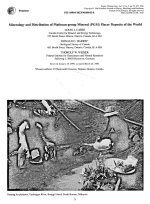Добрый день, Коллеги. Важное сообщение, просьба принять участие. Музей Ферсмана ищет помощь для реставрационных работ в помещении. Подробности по ссылке
Mineralogy and distribution of platinum-group mineral (PGM) placer deposits of the world / Минералогия и распространение МПГ россыпей в мире
Mineralogical studies of platinum-group minerals (PGM) made during the period 1970-1995 are compiled in this paper for PGM obtained from platinum- and gold-bearing placer deposits of fifteen countries. A total of 3399 quantitative electron microprobe analyses of 37 different PGM are presented, together with analytical data plotted on compositional diagrams. The data reflect the dominance of Pt-Fe alloys (1723 analyses) and Os-Ir-Ru-Pt alloys (976 analyses) in the placers. The platinum-group element (PGE) alloys, as well as some other PGM, generally occur as grains less than one millimetre in size. The Pt-Fe alloys, containing some Cu and Ni, are characterized by a wide range of Pt:(Fe, Cu, Ni) ratios and, where sufficient data are available, often show a bimodal population at about 16-17 and 25 at.% (Fe, Cu, Ni). Iridium, osmium, and rhodium occur in trace quantities in over 96% of the analyzed grains, and all three elements were never found to be in concentrations below their detection levels simultaneously. The large data base for the hexagonal alloys shows a well-developed trend parallelling the irascibility gap in the Os-Ir-Ru ternary system. New analyses have narrowed further the width of this miscibility gap, which we postulate to be due to the formation of some alloys at higher temperatures.
Important features of the PGM alloys studied include the presence of inclusions of other PGM (as well as some undefined PGM), PGE-bearing minerals, spinels, silicates, and more rarely sulfides such as chalcopyrite, bornite, and pentlandite, as well as their crystallographic orientation and textures. Alteration and replacement features (when present) are minor, not pervasive, and usually restricted to a limited number of PGM. The sum of the features obtained by detailed mineralogical characterization of the placer PGM is consistent with a high temperature intrusive origin. Evidence of minor secondary alteration that is sometimes found (e.g., irarsite, tulameenite) is probably associated with later processes such as serpentinization. The presence of PGE-oxides and hydroxides (?), all of which are still incompletely characterized, is ascribed to surficial weathering processes. In many cases the placer PGM can be traced to the source intrusive rocks (e.g., zoned ultramafic complex, ophiolite). However, correlation with source rocks is sometimes not possible due to deep weathering, lack of detailed geological maps, or inacessible field areas <...>




